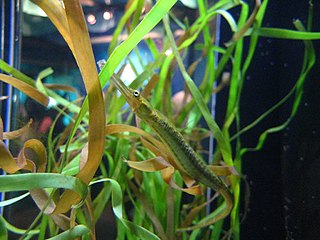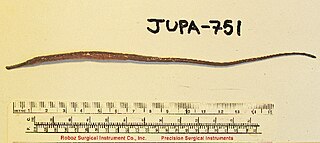
Syngnathus is a genus of fish in the family Syngnathidae found in marine, brackish and sometimes fresh waters of the Atlantic, Indian and Pacific Ocean. Fossils of these species are found from the Oligocene to the Pleistocene. They are known from various localities of Greece, Italy, Germany and United States.
The New Zealand catshark is a catshark of the family Scyliorhinidae in the order Carcharhiniformes. This species is endemic to in the deep waters around New Zealand. Its length is up to 45 centimetres (18 in). The New Zealand catshark is a small, little-known deep water bottom shark. It is dark brown around the top with a few widely spaced pale spots, and white below. It feeds on bottom-living crustaceans. It is also completely harmless to humans.

The greater pipefish is a pipefish of the family Syngnathidae. It is a seawater fish and the type species of the genus Syngnathus.

The lesser pipefish or Nilsson's pipefish is a pipefish similar to the greater pipefish, but with no crest above the head. Usually it reaches up to 17 centimetres (6.7 in) in length, maximally 18 centimetres (7.1 in), although in South Wales they are usually not more than 10 to 13 centimetres long. They have a light to dark green-brown colour with bar-like markings on the sides.

The black-striped pipefish is a species of fish in the family Syngnathidae. It is found in the eastern Atlantic from the southern Gulf of Biscay to Gibraltar, also in the Mediterranean and Black Seas. As the introduced species it is mentioned in the Caspian Sea and fresh waters of its basin.

The estuarine pipefish or river pipefish is a species of fish in the family Syngnathidae. It is endemic to South Africa and has been sporadically recorded in the estuarine portions of the Kariega, Kasouga, Bushmans, East Kleinemonde and West Kleinemonde rivers. It can be readily distinguished from another southern African pipefish with which it shares its habitat, S. temminckii, by its much shorter snout. The estuarine pipefish is most commonly found in beds of the eelgrass Zostera capensis.

The bay pipefish is a pipefish native to the eelgrass beds of the Eastern Pacific, where its sinuous shape and green color allow it to blend in with the waving blades of eelgrass. Like other members of the seahorse family, male pipefish tend the eggs laid by their female partners in specialized pouches.
Pelagic pipefish is a pipefish species of the family Syngnathidae.

The sargassum pipefish is a species of pipefish found in the western Atlantic: Maine, Bermuda, northern Gulf of Mexico to Argentina, Nova Scotia, Antilles, and western Caribbean Sea from Yucatan to Colombia. It is a marine subtropical species, up to 18.1 centimetres (7.1 in) maximal length. This is a little-studied species which is found in floating rafts of Sargassum weed where they are believed to feed on planktonic crustacea. Like other pipefish, this is an ovoviviparous species in which the male carries the fertilised eggs in a brood pouch located under his tail.

The northern pipefish is a northwest Atlantic species of fish belonging to the family Syngnathidae.
The barred pipefish is a species of the pipefishes, widespread in the eastern pacific from the Southern California, United States, to northern Peru. Marine / brackishwater subtropical demersal fish, up to 18.0 cm length.
The dusky pipefish is a species of the pipefishes, widespread in the western Atlantic from the Bermuda, Chesapeake Bay, northern part of the Gulf of Mexico, Bahama, and the western Caribbean Sea to Panama in south. Marine subtropical demersal fish, which lives at the depth up to 22 metres (72 ft), usually up to 4 metres (13 ft). The maximal length of the fish is 25 centimetres (9.8 in).

The southern pipefish is a pipefish species that inhabits the Southwest Atlantic near Uruguay. It is a marine subtropical demersal fish. This species has been recorded among beds of Ruppia maritima in the Lagoa dos Patos in southern Brazil, and apparently they spend the whole of their lives in sea grass beds. It is a carnivorous species which feeds mainly on copepods and isopods, although the females consume a wider variety of prey. It is an ovoviviparous fish, in which the males bear the fertilised eggs inside a brood pouch located beneath its tail. During the breeding season they are sexually dimorphic which indicates that the species is probably polygamous.
The chain pipefish is a pipefish species. It inhabits the western Atlantic from Virginia, Bermuda and northern Gulf of Mexico to Campeche and Jamaica, but is absent from the Bahamas. It is a marine subtropical reef-associated fish, up to 38 cm length.

The Gulf pipefish is a species of pipefish in the member of the taxonomic family Sygnathidae. Syngnathus scovelli is native to the region of south Florida, United States, the Atlantic Ocean, etc. S. scovelli is similar to the species Opossum pipefish also known by its scientific name as Microphisbrachyurus.
The bull pipefish is a pipefish species of the western Atlantic, from southern Canada to Panama. It is a marine subtropical reef-associated fish, up to 38 centimetres (15 in) length.

The kelp pipefish is a species of pipefish. It inhabits the eastern Pacific from the Bodega Bay in northern California, United States, to southern Baja California, Mexico. It is a marine subtropical demersal fish, up to 50 centimetres (20 in) length.
Caribbean pipefish is a species of pipefish. It is widespread in the Western Atlantic near the coasts of South America from Belize to Suriname, as well as from the Greater and Lesser Antilles. Marine tropical reef-associated fish, up to 22.5 cm length.
The Chocolate pipefish is a species of the pipefishes. Widespread in the Eastern Pacific from Redondo Beach in southern California, United States, to central Baja California, Mexico. Marine subtropical demersal fish, up to 25 cm length.
Barcheek pipefish, Syngnathus exilis, is a species of the pipefishes. Widespread in the Eastern Pacific from the Half Moon Bay in central California, United States, to south central Baja California and Guadalupe Island, Mexico. Marine subtropical demersal fish, up to 25 cm length.











